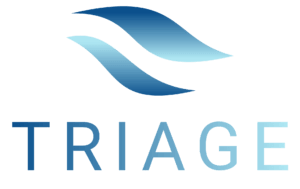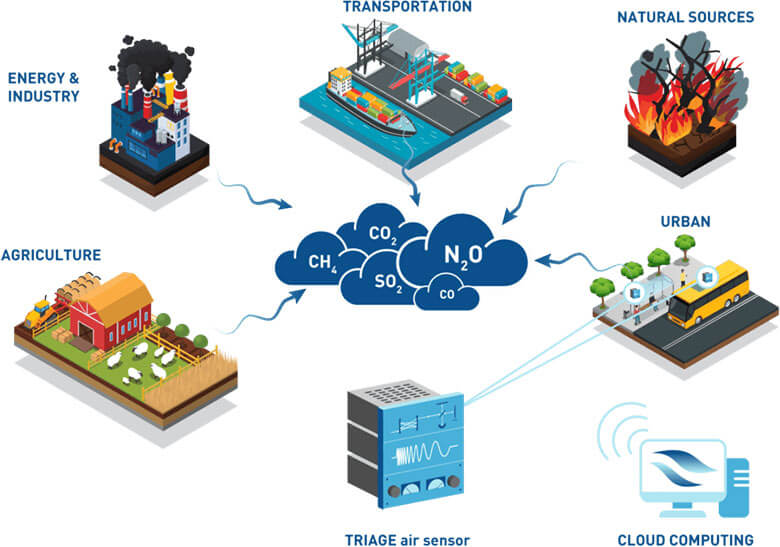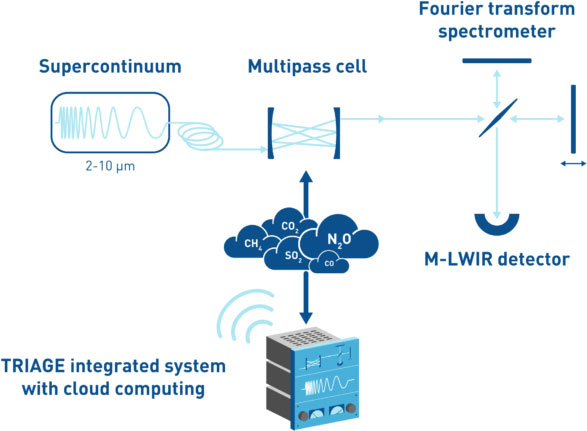Horizon 2020
6 June 2022


Ultra-broadband infrared gas sensor (TRIAGE)
- GA:
- Duration:
- Overall budget:
- EU contribution:
- Project consortium:
- 101015825
- 1/01/2021-29/02/2024
- EUR 5,853,623.50
- EUR 4,994,300.96
- Danmarks Tekniske Universitet (Denmark), Vivid Components Ltd. (United Kingdom), NKT Photonics A/S (Denmark), Stichting Katholieke Universiteit (Netherlands), Senseair AB (Sweden), CSEM Centre Suisse D’Electronique et de Micotechnique SA – Recherche et Developpement (Switzerland), Norblis IVS (Denmark), Linkopings Universitet (Sweden), VIGO Photonics S.A. (Poland)
- GA: 101015825
- Duration: 1/01/2021-29/02/2024
- Overall budget: EUR 5,853,623.50
- EU contribution: EUR 4,994,300.96
- Project consortium: Danmarks Tekniske Universitet (Denmark), Vivid Components Ltd. (United Kingdom), NKT Photonics A/S (Denmark), Stichting Katholieke Universiteit (Netherlands), Senseair AB (Sweden), CSEM Centre Suisse D’Electronique et de Micotechnique SA – Recherche et Developpement (Switzerland), Norblis IVS (Denmark), Linkopings Universitet (Sweden), VIGO Photonics S.A. (Poland)
Terahertz sensors and networks for next generation smart automotive electronic systems 2020 (Car2TERA)
- GA:
- Duration:
- Overall budget:
- EU contribution:
- Project consortium:
- 824962
- 01/01/2019 – 31/03/2022
- EUR 3,999,688.75
- EUR 3,999,688.75
- Technikon Forschungs und, Planugsgesellschaft MBH (Austria), Kungliga Tekniska Hoegskoland (Sweden), Infineon Technologies Austria AG (Austria), Chalmers Tekniska Hoegskola AB (Sweden), Ericsson Telcomunicazioni SPA (Italy), Anteral SL (Spain), Veoneer Sweden AB (Sweden), Ericsson AB (Sweden), VIGO Photonics S.A. (Poland)
- GA: 824962
- Duration: 01/01/2019 – 31/03/2022
- Overall budget: EUR 3,999,688.75
- EU contribution: EUR 3,999,688.75
- Project consortium: Technikon Forschungs und, Planugsgesellschaft MBH (Austria), Kungliga Tekniska Hoegskoland (Sweden), Infineon Technologies Austria AG (Austria), Chalmers Tekniska Hoegskola AB (Sweden), Ericsson Telcomunicazioni SPA (Italy), Anteral SL (Spain), Veoneer Sweden AB (Sweden), Ericsson AB (Sweden), VIGO Photonics S.A. (Poland)

Objective of the project:
The objective of Car2TERA is to develop emerging sub-terahertz (150-330 THz) smart electronic systems based on the latest semiconductor, microsystem and nanoelectronics technologies, and to implement TRL-4 demonstrators in two high potential application scenarios:
– high-resolution, electronic-beam-steering short-range car radar sensors, with the primary application being in-cabin passenger monitoring (the fastest growing car sensor market) for individually and real-time adjusted crash mitigation measures;
– short-range, high data-rate THz-over-plastic wired links for telecommunication radio-access and networks facilitating data growth demanded by 5G and IoT.
The Car2TERA project aims to strengthen European position in the production of advanced, intelligent electronic sensor systems operating in the THz frequency range. European car module manufacturers are holding a market share of 79% on car radars and European semiconductor manufacturers 90% on SiGe car-radar chip sets. The proposed short-range, sub-THz frequency radar technology will also enable new applications, such as in-cabin sensing and significantly improve outdoor sensing including road condition monitoring as essential new features towards the assisted and automated driving and improved road safety.
Car2TERA will develop not only cabin sensors, but also new methods of data transmission using plastic instead of glass fiber, which will be used in the near future to facilitate 5G and Internet of Things communication. Short-distance communication technologies in plastics with high THz-over data rates will be demonstrated at the end of the project.
VIGO Photonics participation:
VIGO Photonics is responsible for the development of radar system demonstrators in sub-THz devices based on new technologies of two-dimensional materials. To make MMIC (monolithic microwave integrated circuit), Vigo intends to use graphene, a single layer of carbon atoms deposited on semiconductor carriers. This will allow to gain better results in comparison to conventional materials.
More information:
Home
Car2TERA_H2020 (@ Car2TERA_H2020) / Twitter
Car2TERA H2020 | LinkedIn
Compact high performance quantum cascade laser sensors (CHEQUERS)
- GA:
- Duration:
- Overall budget:
- EU contribution:
- Project consortium:
- 645535
- 01/03/2015 – 28/02/2019
- EUR 3,325,668.00
- EUR 3,325,668.00
- M‐Squared Laser Limited (United Kingdom), Fraunhofer Institute for Applied Solid State Physics (Germany), Fraunhofer Institute for Photonic Microsystems (Germany), Fraunhofer UK Research Limited (United Kingdom), VIGO Photonics S.A. (Poland), Bundeskriminalamt (Germany), Kite Innovation (Europe) Limited (United Kingdom)
- GA: 645535
- Duration: 01/03/2015 – 28/02/2019
- Overall budget: EUR 3,325,668.00
- EU contribution: EUR 3,325,668.00
- Project consortium: M‐Squared Laser Limited (United Kingdom), Fraunhofer Institute for Applied Solid State Physics (Germany), Fraunhofer Institute for Photonic Microsystems (Germany), Fraunhofer UK Research Limited (United Kingdom), VIGO Photonics S.A. (Poland), Bundeskriminalamt (Germany), Kite Innovation (Europe) Limited (United Kingdom)
Project assumptions:
CHEQUERS will develop two different types of active hyperspectral, real-time and stand-off imaging systems for the civil safety and security markets, both of which will employ the same fundamental detection principles.
The first one of the two systems will be a portable device, catering for the need of early responders and frontline personnel for an easily deployable tool capable of detecting a wide range of threats using a single device. The second imaging system that destined for the surveillance of larger areas. This system will only be marginally larger (shoebox sized) with a form factor that will easily allow mounting the system on a tripod. This increase in size will, however, give the opportunity to utilise more complex components, which will greatly enhance the system’s stand-off and detection limits.
CHEQUERS will:
- Develop low-cost portable sensors for civil security applications
- Create state-of-the-art QCL and MEMS technology
- Couple with industry-leading optoelectronic and system integration
- Provide versatile spectral sensing capabilities in the MWIR
- Develop high volume civil security markets
- Develop cooperative pan-European supply chains
- Maintain focus with strong industrial leadership
- Engage with interested end users from conception to exploitation.
Project operation:
In a world where explosive, toxic or otherwise lethal substances are, sadly, no longer restricted to theatres of war, but are becoming increasingly common in civilian areas (encountered either by misfortune or misadventure), the ability to detect and identify hazardous chemicals and compounds quickly, easily and at significant range is highly attractive. Even after a terrorist attack has occurred, significant danger still exists from the threat of further concealed devices, thus significantly impeding the rendering of aid whilst the scene is declared safe. Whilst there has been significant investment in sensor technology to address this need, no single solution has yet been demonstrated which can fulfil the often conflicting needs of high sensitivity, speed, low cost, ease of use, portability and the ability to detect and identify multiple target molecular compounds against confused and unforgiving scenes. In the CHEQUERS project, deals with this topic by realizing two devices, both based on the same core technologies, which draw on the considerable expertise and excellence of the consortium partners. Crucially, we will be guided by and work in civil security services and in so doing work towards realizing utile, field-deployable (TRL 7) instruments within the time frame of this project. Our commitment to this goal is evident from the inclusion of a steering group within our consortium, composed of an international panel representing potential end users of this technology.
VIGO Photonics’s participation:
VIGO Photonics is responsible for development of the optimized detectors and designing dedicated electronics for fast, low noise amplification of detector signals.
More information:
High sensitivity, portable photonic device for pervasive water quality analysis (WaterSpy)
- GA:
- Duration:
- Overall budget:
- EU contribution:
- Project partners:
- 731778
- 01/11/2016 – 31/10/2019
- EUR 4,133,301.25
- EUR 3,049,206.74
- CyRIC – Cyprus Research and Innovation Centre (Cyprus), National Research Council (Italy), Alpes Lasers SA (Switzerland), National Technical University of Athens (Greece), Technische Universität Wien (TUW), Friedrich-Alexander-Universitaet Erlangen-Nuernberg (Germany), AUG Signals Hellas (Greece), VIGO Photonics S.A. (Poland), IREN SpA (Italy)
- GA: 731778
- Duration: 01/11/2016 – 31/10/2019
- Overall budget: EUR 4,133,301.25
- EU contribution: EUR 3,049,206.74
- Project partners: CyRIC – Cyprus Research and Innovation Centre (Cyprus), National Research Council (Italy), Alpes Lasers SA (Switzerland), National Technical University of Athens (Greece), Technische Universität Wien (TUW), Friedrich-Alexander-Universitaet Erlangen-Nuernberg (Germany), AUG Signals Hellas (Greece), VIGO Photonics S.A. (Poland), IREN SpA (Italy)
Project assumptions:
WaterSpy develops a device for pervasive and on-line monitoring of tap water. For many contaminants, which will lead to human health hazards, good measurement devices are available. For bacterial contamination the situation gets worse. Especially, E. coli, Salmonella and P. aeruginosa are the most dangerous for human health. WaterSpy focuses on these three strains of bacteria and develops an additional device for currently available quality monitoring platforms. The device will be able to perform automated and fast quality analysis for bacterial contaminants in water.
Challenges of the project are to meet the legal requirements for the concentration of contaminants, given in the EU directives on water quality. Due to the very low acceptable concentration of contaminants, the sensitivity of the device has to be very high to catch up with current laboratory analysis.
Key strategic Objectives:
- Development of a compact photonics technology, capable of identification of heterotrophic bacterial cells in the water. Specificity and sensitivity levels will meet regulatory requirements,
- Validation of the profitability and suitability of technology for a large coverage area.
Objective:
The purpose of the WaterSpy team is to develop a device that will require about 30-45 minutes for a full sample analysis of 250 mL. This is in line with the EC and national regulations that require that no bacteria should be present in a sample of 250mL of drinking water. 30-45 minutes will allow to perform 32-48 tests per day in the same site. With currently used systems, the same analysis could take up to 3 days.
Pervasive and on-line water quality monitoring data is essential for detecting environmental pollution and reacting in the best possible way to avoid human health hazards. However, it’s not easy to gather such data, at least not for all contaminants.
Currently, water utilities rely heavily on frequent sampling and laboratory analysis in order to obtain the information. For the situation to be improved, portable and high-performance devices for pervasive water quality monitoring are required. Such devices should expand current limitations in detecting contaminants, transcending today’s paradigms, and bridging available different technologies, allowing on-line monitoring of possible contaminants.
WaterSpy addresses this challenge by developing photonics technology for water quality analysis suitable for inline, field measurements. WaterSpy technology will be integrated, for validation purposes, to a commercially successful water quality monitoring platform, in the form of a portable device add-on. WaterSpy will be used in the field for the analysis of critical points of water distribution networks. This will be demonstrated in two different demo sites in Italy.
Why WaterSpy:
By providing the capability to detect biological agents in the Water network, WaterSpy will effectively contribute directly to increased health and safety of European citizens.
Waterborne infectious diseases not only cause illness and death that can be prevented, but may also have substantial economic effects on the affected people and their families and the society as a whole, including expenses for healthcare and loss of productivity. It has also been proven that adverse health outcomes are associated with ingestion of unsafe water, lack of water access (linked to poor hygiene), lack of access to sanitation, contact with unsafe water, and inadequate management of water resources and systems. Pathogenic microorganisms remain the most important hazard in drinking and recreational water in the European region and digestive track diseases are still an important cause of child morbidity and mortality in some countries. Viruses (rotavirus, calcivirus, and hepatitis A virus) are responsible for 70- 80% of contagious diarrhea cases in the developed world, according to the referenced WHO study. Some of the biological agents used in terrorism cause similar health disorders to the ones mentioned above and other can even cause other more dangerous health hazards.
VIGO Photonics’s participation:
VIGO Photonics is responsible for development of the optimized detector and designing dedicated electronics for fast, low noise amplification of detector signals. The detector will be integrated with electronics into the detection module.
Project partners include:
CyRIC -Cyprus Research and Innovation Centre (Cyprus),
National Research Council (Italy),
Alpes Lasers SA (Switzerland),
National Technical University of Athens (Greece),
Technische Universität Wien (TUW),
Friedrich-Alexander-Universitaet Erlangen-Nuernberg (Germany),
AUG Signals Hellas (Greece),
VIGO Photonicss SA (Poland)
IREN SpA (Italy)
More information:
Broadband tunable QCL based sensor for online and inline detection of contaminants in water (AQUARIUS)
- GA:
- Duration:
- Overall budget:
- EU contribution:
- Project partners:
- 731465
- 01/01/2017 – 31/12/2020
- EUR 3,891,263.75
- EUR 3,891,263.75
- Technikon Forschungs- und Planungsgesellschaft MBH – TEC (Austria), Quantared Technologies Gmbh – QRT (Austria), Fraunhofer Gesellschaft Zur Foerderung der Angewandten Forschung E.V. – Fraunhofer (Germany), OMV Exploration & Production GmbH – OMV (Austria), VIGO Photonics S.A. – VIGO (Poland), Interuniversitair Microelectronica Centrum IMEC VZW – IMEC (Belgium), Technische Universitatet Wien – TU Wien (Austria), KWR Water B.V. – KWR (Netherlands)
- GA: 731465
- Duration: 01/01/2017 – 31/12/2020
- Overall budget: EUR 3,891,263.75
- EU contribution: EUR 3,891,263.75
- Project partners: Technikon Forschungs- und Planungsgesellschaft MBH – TEC (Austria), Quantared Technologies Gmbh – QRT (Austria), Fraunhofer Gesellschaft Zur Foerderung der Angewandten Forschung E.V. – Fraunhofer (Germany), OMV Exploration & Production GmbH – OMV (Austria), VIGO Photonics S.A. – VIGO (Poland), Interuniversitair Microelectronica Centrum IMEC VZW – IMEC (Belgium), Technische Universitatet Wien – TU Wien (Austria), KWR Water B.V. – KWR (Netherlands)
Project assumptions:
AQUARIUS proposes development of a breakthrough method for detecting water pollution by using MIR quantum cascade lasers (QCLs). It is motivated by:
- the EC Water Framework Directive (2000/60/EC) where hydrocarbons are identified as priority hazardous
substances, - the industrial and regulatory need for fast and continuous detection of contaminants,
- the current state-of-the-art on substances’ measurement using QCLs as defined by project partner QuantaRed Technologies and described in ASTM D7678.
Project objective:
Currently, classical research methods are used to control water pollution. Samples collected on site are transported to the laboratory where a number of tests are carried out. AQUARIUS will improve this offline method by developing pervasive online and inline sensing strategies based on advanced photonic structures. For improved specificity a broadly tunable MOEMS based μEC-QCL source will be developed into a core spectrometer. High power, mode-hop free operation and unprecedentedly fast data acquisition will assure high S/N-ratios and thus high sensitivity.
The system for online sensing will be validated by OMV project partner for process and waste water monitoring. It will also be tested for identifying different sources of contaminations by KWR project partner in their water treatment and purification facilities.
The system for inline sensing will be based on integrated optical circuits (IOC) including waveguides for evanescent wave sensing. Switching between individual MKOI waveguides will enable quasi-simultaneous sample and background measurement and thus assure excellent longterm stability.
AQUARIUS covers the supply chain from research institutes to system integrator and end users. It will push the online system from TRL 3 to 7 and the inline system from TRL 2 to 4 and thus reinforce the industrial leadership of the project partners regarding QCL based liquid sensing and photonic components (source, detector and IOCs).
Applications:
By exploiting the online analyser for industrial water monitoring the first targeted users will be from petrochemical industry as their main business is the exploration and refining of. As the level of automation increases, the sensors application in the manufacturing and industrial segment exhibits higher deployment and use possibilities. Increasingly, sensors are deployed to ensure higher production, control wastages, and reduce down-time in the manufacturing sector. Within this focus market potential customers include 750 offshore oil platforms (produced water discharge), 3.500 field laboratories (produced water reinjection), 1.000 refineries (50% are recycling the water from process stream outlets) and 2.000 from further oil-processing-industry (e.g. lubricants industry).
The second major market will be water treatment and purification (including the environmental water monitoring) and drinking water supply. The total available market for water pollution will be of $3.5 billion in 2019 and that for water pollution control is valued as of $2.7 billion with annual growth rates of 5.2%.
On the long term food production can be addressed which is highly reliant on high-quality water resources. Together with the application of inline OiW sensors along the water supply chain the target market (considering multiple use at site) includes 6.000 compact sensors. Based on an estimation 1200 sensors/year can become available within 10 years after the end of the project.
VIGO Photonics’s participation:
VIGO Photonics is responsible for development of the optimized detector and designing dedicated electronics for fast, low noise amplification of detector signals. The detector will be integrated with electronics into the detection module.
An analog to digital data conversion system with MSamples/second conversion rate will be developed. High speed sampling synchronization with pulsed laser operation will be realized with a powerful FPGA system, integrating fast static RAM memory to store and process samples.
More information:
https:/twitter.com/aquarius_h2020
https:/www.facebook.com/Aquarius-2016358345254577/
https:/www.linkedin.com/in/aquarius-project-8a7144133/
https:/aquarius-project.eu/downloads/AQUARIUS-Newsletter-Issue1.pdf
Mid infrared photonics devices fabrication for chemical sensing and spectroscopic applications (MIRPHAB)
- GA:
- Duration:
- Overall budget:
- EU contribution:
- Consortium members:
- Industrial partners:
- 688265
- 01/01/2016 – 30/06/2021
- EUR 16,367,797.07
- EUR 12,980,217.39
- Nanoplus Nanosystems and Technologies GmbH (Germany), Alpes Lasers SA (Switzerland), Mirsense (France), IQE (France), Fraunhofer IAF (Germany), Fraunhofer IPT (Germany), CSEM (Switzerland), Compound Semiconductor Technologies (United Kingdom), Fraunhofer IPMS (Germany) , IMEC (Belgium), Leti CEA tech (France), Fraunhofer IAF (Germany), III-V Lab (France), VIGO Photonics S.A. (Poland), Synopsys (PhoeniX Software), Tematys (France), EPIC (France)
- Electrolux, QUANTA RED Technologies (Austria), NEO Monitors (Norway), Cascade Technologies (United Kingdom)
- GA: 688265
- Duration: 01/01/2016 – 30/06/2021
- Overall budget: EUR 16,367,797.07
- EU contribution: EUR 12,980,217.39
- Consortium members: Nanoplus Nanosystems and Technologies GmbH (Germany), Alpes Lasers SA (Switzerland), Mirsense (France), IQE (France), Fraunhofer IAF (Germany), Fraunhofer IPT (Germany), CSEM (Switzerland), Compound Semiconductor Technologies (United Kingdom), Fraunhofer IPMS (Germany) , IMEC (Belgium), Leti CEA tech (France), Fraunhofer IAF (Germany), III-V Lab (France), VIGO Photonics S.A. (Poland), Synopsys (PhoeniX Software), Tematys (France), EPIC (France)
- Industrial partners: Electrolux, QUANTA RED Technologies (Austria), NEO Monitors (Norway), Cascade Technologies (United Kingdom)
Project assumptions:
The MIRPHAB consortium aims to establish a pilot line to serve the growing needs of European industry in the field of analytical micro-sensors. Its main objectives are to:
- provide a reliable supply of mid-infrared (MIR) photonic components for companies incl. in particular SMEs already active in analytical MIR sensing
- reduce investment cost to access innovative MIR solutions for companies already active in the field of analytical sensors, but new to MIR photonics based sensing
- attract companies new to the field of analytical sensors, aiming to integrate μ-sensors into their products.
To fulfil those objectives, MIRPHAB is organized as a distributed pilot line formed by leading European industrial suppliers of MIR photonic components, complemented by first class European R&D institutes with processing facilities capable of carrying out pilot line production.
MIRPHAB provides:
- access to MIR photonic devices via mounted/packaged devices for laser-based analytical MIR sensors
- expert design for sensor components to be fabricated in the pilot line plus training services to its customers.
Project operation:
The platform will be organized in such a way that new developments in MIR micro- and integrated optic components and modules can be taken up and incorporated into the MIRPHAB portfolio. MIRPHAB will work on a convincing scheme for the flow of hardware and information, suitable to operate a distributed pilot line efficiently. MIRPHAB will develop solid business cases and a compelling business plan. Potential cost-performance breakthroughs will be shown for reliable MIR sensing products based on building blocks provided by MIRPHAB. MIRPHAB will become a sustainable source of key components for new and highly competitive MIR sensors, facilitating their effective market introduction and thus significantly strengthening the position and competitiveness of the respective European industry sector.
VIGO Photonics’s participation:
- postprocessing and encapsulation of detectors from partners
- characterization and assessment of the implementation readiness of new types of detectors
- integration of detectors with electronics and passive components
- active participation in the expert group, evaluation of submitted applications
- construction / integration of demonstrators or their fragments for project clients.

















